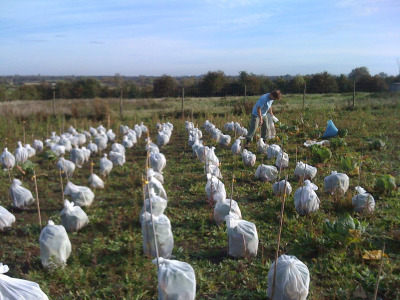
News
Studying the optimal ecology of a bio-insecticide
May 21, 2010 By Biotechnology and Biological Sciences Research Council (BBSRC)
May 21, 2010, London, England – BBSRC-funded researchers at
the University of Oxford and Royal Holloway University of London have
discovered that the commonly used and naturally occurring bacterial
insecticide
Bt works best if applied to young plants and is enhanced by the presence
of the
insect pests.
May 21, 2010, London, England – BBSRC-funded researchers at
the University of Oxford and Royal Holloway University of London have
discovered that the commonly used and naturally occurring bacterial insecticide
Bt works best if applied to young plants and is enhanced by the presence of the
insect pests. The research was published yesterday (May 20) in the open-access
journal PLoS Pathogens.
Spraying Bt – the bacterium Bacillus thuringiensis – is a
common method for controlling a variety of insect pests and is one of the main
approaches to chemical-free pest control in agriculture. Optimizing sustainable
farming techniques can help meet the challenge of feeding nine billion people
by 2050 using fewer resources and with minimum impact on the environment.

|
| Researchers working in the field where different conditions are trialled in the experiment. Cabbages are protected in bags from unwanted insects. PHOTO © DR. MIKE BONSALL, UNIVERSITY OF OXFORD |
“Bt has been used commercially for about 40 years and is
readily available to control pest moths and the like, but until now we've known
very little about the natural abundance of the bacteria in the environment and
what happens when we apply extra bacteria as a means of pest control,” said
senior researcher Dr. Mike Bonsall at the University of Oxford. “It's really
important to understand what is happening so that we can, for example, know
what factors might have an impact on the insects becoming resistant to Bt.”
Bt is found naturally in soils and on plants and exists as
many different varieties that each have a preference for infecting different
organisms. Bt strains that are specific to certain insects rely on being able
to infect those insects in order to reproduce. The researchers studied a strain
called ST8, which infects the Diamondback Moth – a pest that attacks cabbages,
broccoli and related crops – and they found that the population of bacteria
(either existing or applied) establishes itself more readily when the insects
are present.
The team set up several cabbage plots in the field to
examine what was happening when there were extra insects and/or extra bacteria
added to what was already present. Then they took samples of soil and leaves.
For each sample they looked at the genetics of the bacteria to build a profile
of which strains of Bt were present and in what numbers.
“We found that our strain, ST8, is the most common in the
environment already and it also seems to be best at getting onto the leaves
where it can infect the moths,” said lead researcher Dr. Ben Raymond at Royal
Holloway University of London. “We think that the ST8 that exists naturally in
the farm environment might well be colonizing the plant as growing seedlings so
it gets the earliest possible opportunity to infect the moths, which of course
it needs to do to survive.
“This makes sense given that we also found that when there
are extra insects in the environment the bacteria actually do much better and
can be found in larger numbers. It also shows why spraying the plants,
especially young ones, rather than the soil is the best way of using Bt to
control insect pests.”
The research team is also looking at factors that affect the
chances of insects becoming resistant to Bt. In particular, they are looking at
the way the toxin that kills the insect and an antibiotic that Bt produces to
get rid of competing strains of bacteria in the insect's gut both impact the
evolution of resistance in the insect.
Professor Douglas Kell, BBSRC chief executive officer, said that
“sustainable solutions to future food security will rely on a thorough
understanding of how ecosystems operate. This is a good example where the
interactions between different parts of such a system have a significant impact
on how we can control pests using biological rather than chemical methods. It
is also vital that our ongoing practices with Bt present minimal risk of
insects becoming resistant and so work to understand the fundamental biology
that happens within this system is extremely important.”
BBSRC
is the U.K. funding agency for research in the life sciences. Sponsored
by government, BBSRC annually invests around £470 million in a wide
range of research that makes a significant contribution to the quality
of life in the U.K. and beyond and supports a number of important
industrial stakeholders, including the agriculture, food, chemical,
healthcare and pharmaceutical sectors.
Print this page